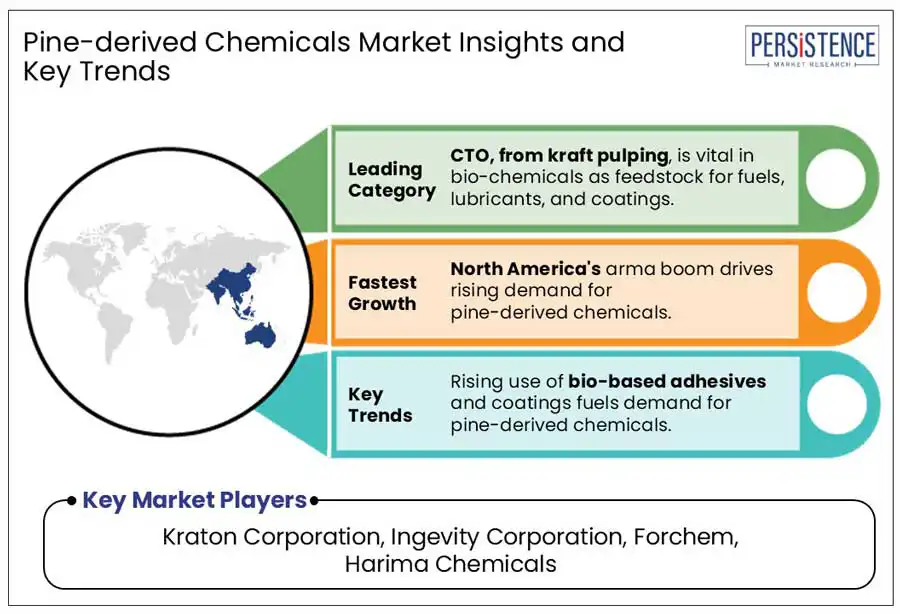Comprehensive Snapshot of Pine-derived Chemicals Market Research Report, Including Regional and Country Analysis in Brief.
Industry: Chemicals and Materials
Published Date: April-2025
Format: PPT*, PDF, EXCEL
Delivery Timelines: Contact Sales
Number of Pages: 190
Report ID: PMRREP35248
The global pine-derived chemicals market size is anticipated to rise from US$ 6.3 Bn in 2025 to US$ 8.7 Bn at a CAGR of 4.7% by 2032. According to the Persistence Market Research report, the rise in demand for bio-based adhesives, coatings, pharmaceuticals, and biofuels are widely evident. Sourced from pine trees and pulping processes, these sustainable chemicals are widely used across manufacturing industries. Globally, products made with pine chemicals have a 50% lower carbon footprint and a 56% reduced non-renewable energy footprint compared to substitutes.

Key Industry Highlights:
|
Global Market Attribute |
Key Insights |
|
Pine-derived Chemicals Market Size (2025E) |
US$ 6.3 Bn |
|
Market Value Forecast (2032F) |
US$ 8.7 Bn |
|
Projected Growth (CAGR 2025 to 2032) |
4.7% |
|
Historical Market Growth (CAGR 2019 to 2024) |
4.4% |
The increasing shift toward sustainable bio-based alternatives is a major driver of the pine-derived chemicals market. As industries seek eco-friendly substitutes for petrochemical-based products, pine-derived chemicals. Kraton a leading global producer of crude tall oil (CTO), crude sulfate turpentine (CST) pine-based chemicals, and specialty resins offers a biobased alternative to fossil-based materials that perform better and have a reduced carbon footprint, providing more sustainable chemistry for a wide range of industries. Environmental regulations such as the EU Green Deal and the U.S. Renewable Fuel Standard (RFS) accelerates demand for bio-based materials, pushing industries to replace synthetic chemicals with low-carbon, biodegradable solutions. This shift is expected to drive long-term market growth, positioning pine-based materials as key players in the green transition.
Despite the growing shift toward sustainable solutions, the pine-derived chemicals market faces significant competition from petrochemical-based alternatives. Petroleum-based adhesives, coatings, and lubricants often offer lower production costs, higher availability, and more consistent quality, making them the preferred choice for many industries.
Additionally, fluctuations in raw material supply for pine-derived compounds, caused by limited forestry resources and climate conditions, result in increased production costs. In contrast, the petrochemical industry benefits from well-established supply chains and economies of scale, allowing it to provide low-cost synthetic replacements.
The increasing adoption of pine-derived chemicals in coatings presents a major growth opportunity for the market. Rosin, tall oil, and turpentine-based derivatives are being widely used in protective coatings, paints, and varnishes due to their natural durability, adhesion properties, and resistance to environmental factors. In 2023, AkzoNobel collaborated with KIA Motors to develop the first bio-based interior coating for the new EV9 electric SUV. This innovative paint incorporated two types of bio-rosin: one extracted from rapeseed and the other from pine rosin.
Stringent environmental regulations restricting VOC emissions are driving demand for low-toxicity, bio-based coatings. With continued innovations in high-performance, sustainable coatings, the pine-derived chemicals market is set to expand, offering a renewable and eco-friendly solution for long-term protection and durability.
CTO, a byproduct of the kraft pulping process, plays a crucial role in the bio-based chemicals industry, serving as a key feedstock for biofuels, lubricants, and coatings. CTO contains fatty acids, rosin acids, and sterols, making it highly versatile for industrial applications. SunPine and Preem have developed a commercial process to produce bio-based diesel fuels using Crude Tall Oil (CTO), a byproduct of the pulp and paper industry. SunPine manufactures Raw Tall Oil Diesel, which Preem refines into HVO Tall Diesel, supplying nearly half of Preem’s biodiesel market share. Additionally, CTO is widely used in high-performance industrial lubricants and protective coatings, offering superior adhesion, corrosion resistance, and durability. As bio-based solutions gain momentum, CTO is set to remain a key driver of green industrial transformation.
Rosin plays a critical role in rubber formulations, primarily as a tackifier, enhancing adhesion, flexibility, and processing efficiency in tire manufacturing. Its natural resin acids improve the mechanical properties of rubber, ensuring better grip, durability, and wear resistance. The automobile and tire industry is experiencing significant growth, driven by rising vehicle production, increasing demand for electric vehicles (EVs), and expanding infrastructure development.
With global shifts toward sustainable mobility and green materials, rosin-based rubber additives are set to play a pivotal role in the future of tire manufacturing. Kraton's SYLVATAC™ series offers rosin ester tackifiers compatible with various polymers, including ethylene-vinyl acetate (EVA), acrylics, styrene-butadiene rubber (SBR), styrene-isoprene-styrene (SIS), and styrene-butadiene-styrene (SBS). This compatibility provides formulation flexibility in hot-melt, water-based, and solvent-based adhesives.

The pharmaceutical sector in North America is experiencing rapid growth, significantly boosting the demand for pine-derived chemicals. North America remains the world's largest pharmaceutical market, accounting for 41% of global spending on pharmaceuticals. The region is home to leading pharma and biopharma companies and drug developers, making it a hub of innovation. Sterols, rosin, and turpentine produced from pine trees are essential components of medication formulations, excipients, and active pharmaceutical ingredients (APIs).
Sterols from CTO are used in cardiovascular medicines, dietary supplements, and hormone-based pharmaceuticals. Chemicals from turpentine are key in antiseptics, decongestants, and medicinal balms, with growing consumer demand for natural and plant-based products driving this trend. Turpentine is derived from pine resin, contains monoterpenes like alpha-pinene and beta-pinene. It is used for muscle and joint pain relief and is a key ingredient in topical formulations for cough treatment, often combined with thymol and camphor.
The European Green Deal and REACH rules have accelerated the transition to sustainable, bio-based materials, dramatically increasing demand for pine-derived compounds. These policies focus on decreasing carbon footprints, regulating harmful compounds, and promoting renewable alternatives to petroleum-based chemicals. Strict REACH regulations are driving producers to replace petrochemicals with safer, biodegradable alternatives, making pine-derived compounds an excellent choice. Henkel Adhesive Technologies, Kraton Corporation, and Dow partnered to improve the sustainability of packaging adhesives. By incorporating bio-based alternatives, they achieved a 25% reduction in the carbon footprint of Henkel's TECHNOMELT SUPRA 100 and 106M adhesives. Kraton's REvolution™ rosin ester technology is key to this advancement, highlighting the potential for sustainability in adhesive manufacturing.
Asia-Pacific dominates the pine-derived chemicals market, primarily due to its vast forest resources and strong industrial infrastructure. Countries like China, India, Indonesia, and Japan have an abundant supply of pine trees, which serve as a key raw material for producing rosin, turpentine, and crude tall oil (CTO). China, the world’s largest producer of gum rosin, benefits from extensive pine forestry and a well-established resin-tapping industry.
China's pine trees contribute approximately 500,000 tons of pine gum annually, making it the world’s largest producer of pine-derived chemicals. This vast supply enables the country to manufacture around 350,000 to 400,000 tons of gum rosin and 46,000 to 50,000 tons of gum turpentine per year. The region’s cost-effective labor and manufacturing capabilities further strengthen its position in the market. APAC’s demand for bio-based, sustainable alternatives continues to rise, ensuring the continued dominance of the region in the pine-derived chemicals market.
The global pine-derived chemicals market is highly competitive, with regional producers and global manufacturers competing for market share. Key players operate across North America, Europe, and Asia Pacific, leveraging supply chain integration, technological advancements, and sustainable sourcing to gain a competitive edge.
Asia Pacific leads in raw material availability and cost-effective production, while North America and Europe focus on high-value, processed derivatives such as bio-based adhesives, coatings, and lubricants. Innovation in tall oil refining, rosin esterification, and terpene applications is shaping industry growth. Companies invest in R&D and sustainability initiatives to align with regulatory standards and bioeconomy trends.
|
Report Attribute |
Details |
|
Historical Data/Actuals |
2019 - 2024 |
|
Forecast Period |
2025 - 2032 |
|
Market Analysis Units |
Value: US$ Bn/Bn, Volume: As applicable |
|
Geographical Coverage |
|
|
Segmental Coverage |
|
|
Competitive Analysis |
|
|
Report Highlights |
|
|
Customization and Pricing |
Available upon request |
By Product Type
By Industry
By Region
To know more about delivery timeline for this report Contact Sales

The Pine-derived Chemicals market is estimated to be valued at US$ 6.3 Bn in 2025.
Pine-derived Chemicals as sustainable bio-based alternatives to petrochemical-based chemicals is a key driver.
In 2025, Asia Pacific dominates with a 23.2% share in the global Pine-derived Chemicals market.
Among product type segment, demand from crude tall oil segment is expected to grow rapidly.
Kraton Corporation, Ingevity Corporation, Forchem, and Harima Chemicals are the leading players in Pine-derived Chemicals market.